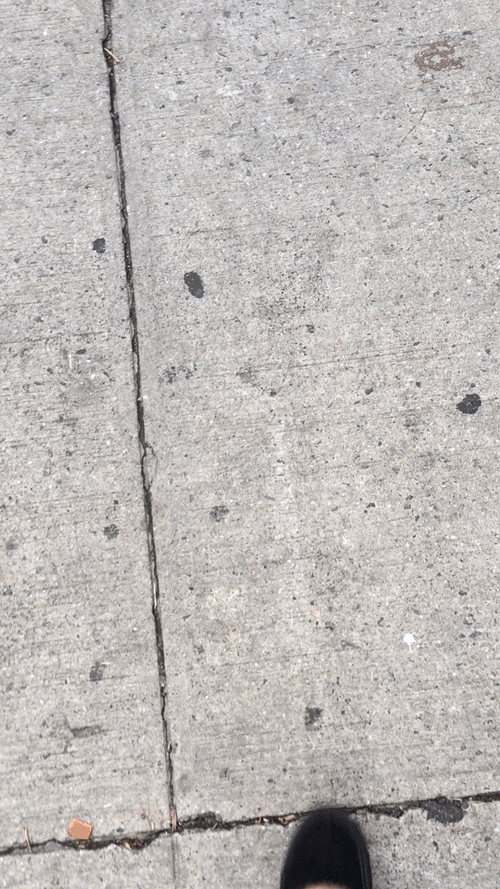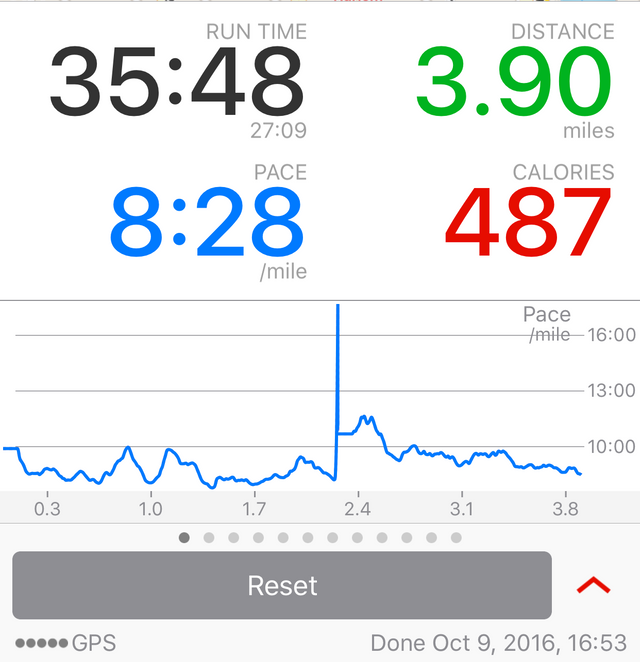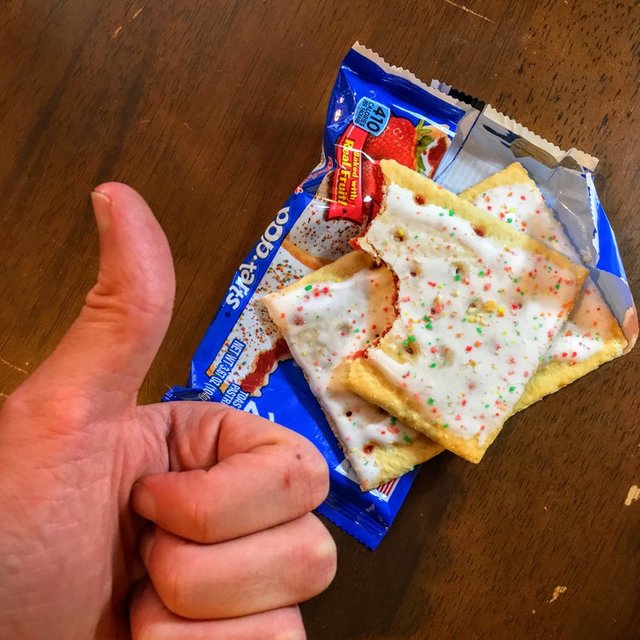This is the first of 5 posts in a series I’m writing about learning to run.

I do not represent the #besomebody app with that hoodie, I yoinked for free at an art show…is the motto corny or tautological?, only you can decide!
Recently, a friend convinced me to run the Poland Spring Marathon Kickoff, a 5-mile race around Central Park in NYC. It’s at 8:30am on the 30th of October, and I officially started training two days ago, which gives me 21 days or 3 weeks. I plan to write 5 posts about, so one post every 4 days, plus one after race day.
One of the things that motivated my friend to run was the experience of watching someone close to them lose the ability to walk. We’re only able-bodied until we’re not. That motivated me to run too. If you think you might like to try it, you should sign up for a race too!
Speaking of which, what is #PoptartPentathlon? This is just a running race, not a pentathlon! But I’m writing 5 posts, the race is 5 miles long, and I eat Poptarts after I train as a pavlovian reward. Also I wanted an ironic post-hashtag slogan.
In each entry I’ll write about what I’ve learned since the last one. I’ll cover:
- Academic Research and Advice
- Nutrition
- Equipment
- My Experiences in Training
Please give me any suggestions and feedback in the comments; let’s get started!
Academic Research and Advice
“2–20s” Intervals
Someone did a study which found that 10 minutes of intervals was just as beneficial as 50 minutes moderate exercise. The study was conducted with cycling, but I’m using it for running. The study’s conclusion states:
“Twelve weeks of brief intense interval exercise improved indices of cardiometabolic health to the same extent as traditional endurance training in sedentary men, despite a five-fold lower exercise volume and time commitment.”
The intervals go: 3 sets of 2 minute 10% slow jogs followed by 20 second 100% sprints, and a 3 minute cooldown. I call it 2–20s, because I don’t think it has a name yet.
I’ve already done a few of these out of curiosity in the past, and they’re really tiring and satisfying. I also just find sprinting to be way more fun than running at a moderate pace :).
Achieve maximum gains by training to 50–60% of your maximum capacity for a given workout activity
This is something I learned in Europe. Esteban Gorostiaga Ayestaran, a Sports Medicine Doctor and my host dad when I lived abroad in Spain, has done lots of research on the most effective ways to work out. When I think of him and his life’s work, I think of “exercise smart, not hard.”
This is the guy who used to work for the Barcelona soccer team in one of their winning years. He's famous for not letting the players drink Coca-Cola with their every meal. One time he had to stop Lionel Messi from sneaking sugar packets into his orange juice!
His main conclusion from many studies on different kinds of exercise is this (paraphrasing):
“The Americans often get it wrong by training to their maximum capacity too often, it damages their muscles and results in lower improvements. Our research shows that the largest consistent gains happen when you train consistently but to lower capacity, around 50–60%.
I’ll email him and ask him for a better description, but this is what I remember from when I asked him how I should increase my maximum bench. There was lots of math involved, and ended up increasing some crazy amount the few months I was there.
So, if I can run a maximum of 2 miles at a 7 minute pace before passing out, for example, I should never run more than 1.2 miles at that pace when training. The exception, of course, would be testing for my new maximum after training for a while.
When to Run
I also know from what I’ve read in the past out of curiosity that in the late afternoon these things happen to your body:
- Higher oxygen consumption
- Higher testosterone
- Warmer core temp (higher strength and endurance, flexibility)
- Higher reaction time
- Low blood pressure
- Low heart rate
- Low cortisol
All of these things make 5–6pm the best time to work out (depending on your natural sleep schedule). None of this helps me much though, because my race is at 8:30am, which I want to try and get used to.
Nutrition
I’m 6'2", 165 lbs., and 23 years old. My metabolism lets me eat whatever I want and not gain weight. Which is cool until you realize that you can eat anything you want and not become visibly unhealthy, while at the same time becoming invisibly unhealthy.My daily diet usually goes:
- Eggs and vegetables
- Takeout or just nothing
- Whatever terrible atrocities I wish to commit upon my gut
I don’t know what the optimal running diet is but I’m willing to gander that it’s not this.
I take some supplements, which I think I’ll save for my next post. The key ones for running are probably Creatine, L-Citrulline, BCAAs, and trace minerals.
I need to do more research on what to eat (not that common sense couldn’t improve what it is now). I also need to do research on the optimal time to eat before a race, and in what quantity. Since the race is at 8:30am, my guess is I’ll need to get up a few hours earlier than that to eat.
Equipment
I own one pair of shoes, flat Vans skate shoes. I own one pair of shorts, an official pair of training shorts from the Barcelona soccer team, which I received as a gift 6 years ago. I don’t have a non-cotton shirt or even running shoes, so this will be an area of much improvement :).
First up is some running shoes.
A long time ago I owned some Skora “zero-drop shoes”, which are barefoot-style and have zero heel-toe drop, which means the heel of the shoe is no thinker than the toe. The flatness really helped me have a natural stride and footfall, since landing on your heel when there’s no big cushy sole hurts a lot. Here’s a good video explaining it.
The tradeoff is that changing to a forefoot strike means that your calf muscles become the cushy sole replacement, basically big springs, so it hurts at the beginning and takes a while to get used to.
The thing is, the Skora shoes I want, and basically all their other shoes, are all sold out. I don’t know why, I even emailed them and they said they couldn’t give me an estimate on when any of their shoes would be back in stock. So I’ll probably buy some super cheap zero-drop shoes on Amazon and wait it out.
Apple Watch
I have an Apple Watch, whose only real use so far has been to tell me when my pizza is here and occasionally help me not be late for a meeting. I can’t really tell what I’d use it for with running, does anyone have any suggestions? For now I’ll use my phone.
Apps
I’ve played around with a few apps in the past, and this time I found one called Runmeter. So far it gives me lots of options for setting up custom intervals, and records lots of data to look at later; it even automatically exports my runs to Google Calendar! (Are these things other apps do? I have no idea.)
Training and My Experiences

On my first day I decided to run the race course and see how I felt. When I got to 2.23 miles at a ~9:00 pace, I felt at 80% capacity or so, and had a sharp cramp in my chest under my ribcage. So I stopped and walked.
I usually have to stop running because of cramps, I always get them and I don’t know why, it’s something I need to research. Maybe I need to add more time without eating or drinking ahead of my runs, or keep my core more rigid. Sometimes when I relax my core and massage the cramp while I keep running it goes away, but often they don’t.
After walking slowly along the course for 27 minutes while making a phone call, I decided to run again, and ran another 1.67 miles to the end of the course.

That spike tho
Here are the stats. For some reason the app is displaying my average pace for the current split as the the pace, and not my overall average. My overall average pace was 9:10.
I haven’t picked a goal for a target time to complete the race, but I have a lot of work to do! At this point I didn’t even complete the race distance without a break!
The next day I was feeling pretty sore, and had read about people spacing out hard training with a recovery run. So I set Runmeter to yell at me if I ran faster than 11:00 or slower than 15:00, and decided to run to about 50% capacity (a guess, I haven’t tested my max at this pace yet).
The recovery run was nice, I ran 1.54 miles at a 10:31 pace, and afterwards I felt tired but not in pain. I did some static stretching to make sure I stay loose.

Poptart recovery food best recovery food.
And of course, after my first run I ate Poptarts. The classic: strawberry, untoasted.Onward to the finish line!